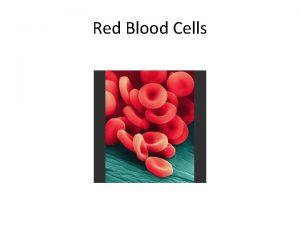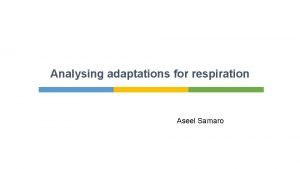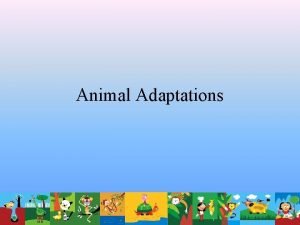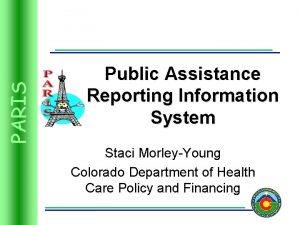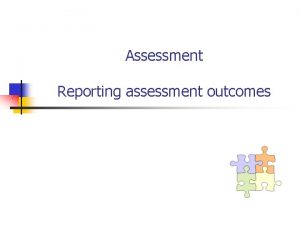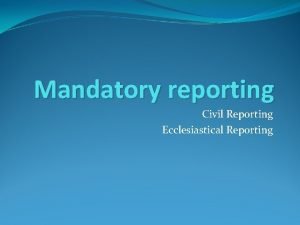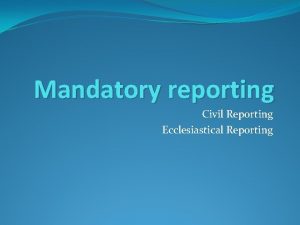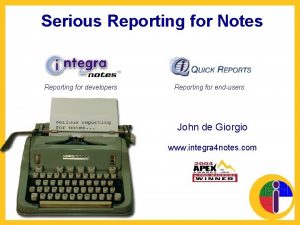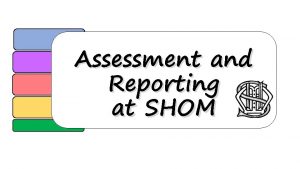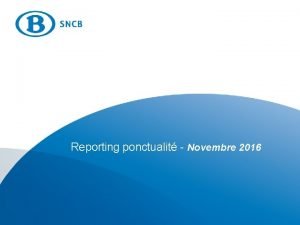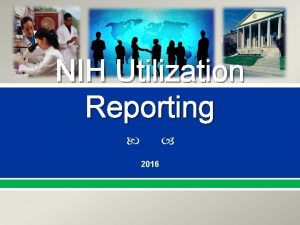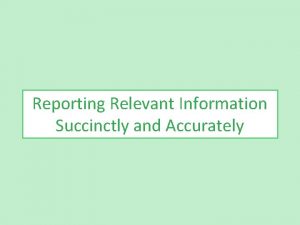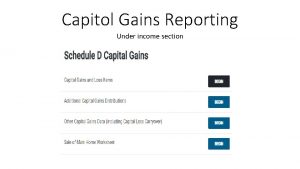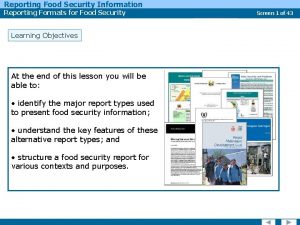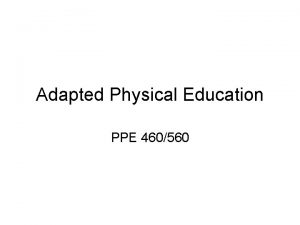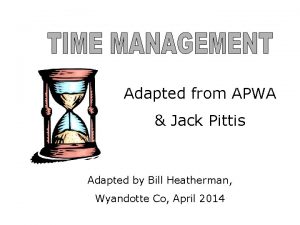Reporting Assessment Information Assessment ReportITP Adapted 2016 Assessment





















- Slides: 21

Reporting Assessment Information (Assessment Report/ITP) Adapted 2016

Assessment Report Similarities with ITP/PS and SOAP Note ITP/PS Assessment Report Subjective Background Information Statement of Problem Background Information Objective Current Assessment Results Long-Term Goals - Results Short-Term Objectives -Results Assessment Comments & Impressions Summary & Conclusions Plan Recommendations (Goals) Recommendations

Header • See template • Where to find diagnostic code

Statement of Problem • Referral source • Reason for referral – Description of communication/swallowing problem • What has helped to improve the problem?

Background Information • • • Medical hx Developmental hx (peds) Social/family hx Educational/ vocational hx Previous tx • Where do you find this information?

Assessment Results • Articulation/Speech Sounds • Language – – Receptive Expressive Reading Writing • Cognitive Function • Swallowing (can note from previous reports or noted concerns) • Oral-Motor Function • Fluency (can note from observation) • Voice (can note from observation) • Hearing (note from previous report or conduct a screening) • Behavioral Observations

What sections do I use for my assessment report? • Identify the relevant areas based on the client’s presenting problem – Young child with speech sound problems – School-age child with social communication problems – Adult client with attention/memory problems – Adult client with hx of stroke and aphasia • Comment on relevant areas even if no problem identified

Describe the Test Example PPVT-4 • The Peabody Picture Vocabulary Test, Fourth Edition (PPVT-4; Dunn & Dunn, 2007) was administered on 2/1/11 to measure Marian’s ability to understand spoken words. The PPVT -4 is a standardized test that assesses an individual’s comprehension and acquisition of vocabulary. As part of this test, the individual points to a picture on a four-picture page layout that corresponds to the word spoken by the examiner.

Reporting Results from Standardized Assessments - Example Marian was focused throughout testing and followed directions without difficulties. Results for PPVT-4; Form A Raw Score Standard Score 55 88 Confidence Interval (90% Level) 82 -94 Percentile 21 Mean Standard Score = 100; Standard Deviation +/- 15

Reporting Results for Speech Sound Disorders • Table with raw scores, standard scores, etc. • What other information would you report? – Speech sound inventory – Sounds in error (give examples!) – Phonological processes – Stimulability

Reporting Results for Language Disorders • Table with raw scores, standard scores, etc. • What other information would you report?

Assessment Analysis • This section is very similar to your “A” section of your SOAP note. • Interpret the information from your assessment sections. You can do this within your report following your individual assessments or make it a separate heading. The important piece is that you provide an interpretation of what your assessment data suggests, coupled with your client observations. • This information should drive your recommendation section • Note: Your assessment section may reflect student speech and language concerns in multiple areas and along the speech and language continuum. However, this is where you will note the most relevant areas to address in terms of student abilities, the developmental continuum, what might be being addressed within the public schools, and/or parent’s immediate concerns.

Summary & Conclusions • Interpretation of Results – Repeat client’s name and age – What do the assessment results mean? • Summarize problem area/s (diagnosis) • Severity of problems area/s • Summarize strengths – Prognosis • E. g. , state how client would benefit from therapy • Support for therapy

Summary & Conclusions Example PPVT-4 • Results show that Marian’s ability to understand spoken words was below average compared to other children her age. This was based on a percentile rank of 21, which showed that Marian performed as well or better than 21% of children her age.

Recommendations • Statement about client/family input regarding plan – Were recommendations developed in collaboration with client? • Recommendations for therapy – Frequency – Duration • • • If no treatment, are follow-up visits planned? Goals Treatment focus and approach Client/family education/training Any additional evaluations? Referral?

Tips for Writing Assessment Reports • Use “positive language” as appropriate – Focus on strengths and areas to improve – Compare to typically developing in kind and subtle ways • State if an observation was reported by the parent (rather than observed by you) – E. g. , “According to (client’s) parent …. ”

Tips for Writing Assessment Reports • Use personal pronouns where appropriate – E. g. , use “we found…” rather than “the clinician found …” • Avoid “the parent”, “the teacher”, “the clinician” • Active voice is easier to follow, but passive voice might be appropriate at times • Think about the meaning of words – E. g. , “She has struggled with spontaneous and consistently accurate production of /sp/ in words. ” – “She has not yet mastered spontaneous and consistently accurate production of /sp/ in words. ”

Tips for Writing Assessment Reports • Don’t end a sentence with a preposition or verb – “MCMA fell outside of the range that the test is standardized for”, – “MCMA was focused on the particular toy he was playing with. ” – “The checklist is a simple way to inventory the speech sounds a child has” – “The speech sound checklist is a parent completed questionnaire indicating the consonant and vowel sounds that the child produces”.

Tips for Writing Assessment Reports • Use clear and simple but professional language – Results from the CDI show MCMA’s weakness in understanding words and an evident problem with his ability to produce speech sounds. – However, MCMA did show some strength in performing actions with objects in addition to symbolic play. – Concerning eating and drinking, MCMA performs related tasks very slowly, seeming to lack mouth strength. – However, he still requires some development in following simple/complex directions and imitating words during play.

Tips for Writing Assessment Reports • Professional jargon needs to be explained, but shouldn’t be avoided – Ear tubes – Provide examples

Review report with client • • Explain results Explain any terms that might not be familiar Explain any statistical terms Ask client/parents – Does report reflect client’s problems? – Are recommendations appropriate? – Do goals reflect what has been discussed?
 This passage is adapted from jane austen
This passage is adapted from jane austen Erythroposis
Erythroposis Adapted with permission from
Adapted with permission from In what ways have the highland maya adapted to modern life?
In what ways have the highland maya adapted to modern life? Xerophytic adaptations
Xerophytic adaptations Chaparral biomass
Chaparral biomass Mensajes subliminales camel
Mensajes subliminales camel Adapted animals in the rainforest
Adapted animals in the rainforest Brother quotes from brother
Brother quotes from brother Adapted from the internet
Adapted from the internet How is amoeba adapted for gas exchange bbc bitesize
How is amoeba adapted for gas exchange bbc bitesize How have plants adapted to the rainforest
How have plants adapted to the rainforest What is spermopsida
What is spermopsida The outsiders adapted for struggling readers
The outsiders adapted for struggling readers Reaction synoynm
Reaction synoynm How are giraffes long necks adapted to their lifestyle
How are giraffes long necks adapted to their lifestyle Afirs
Afirs Paris project medicaid
Paris project medicaid Word 2016 session 2 post assessment
Word 2016 session 2 post assessment Similarities of ncbts and ppst
Similarities of ncbts and ppst Curriculum assessment and reporting framework
Curriculum assessment and reporting framework Safety assessment for ind safety reporting
Safety assessment for ind safety reporting

